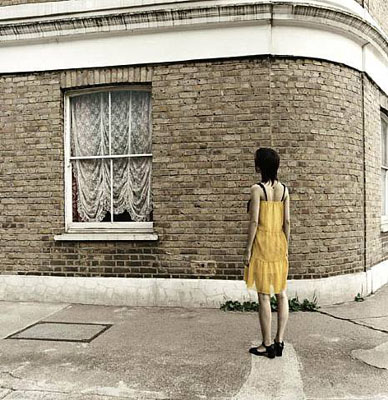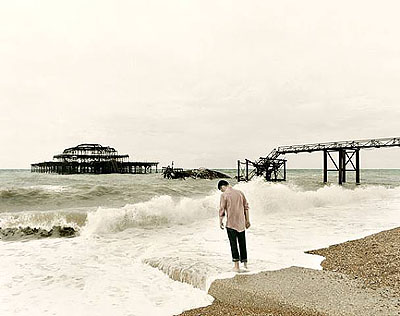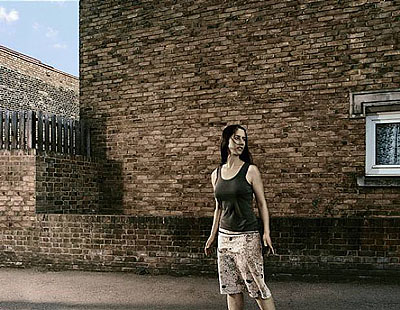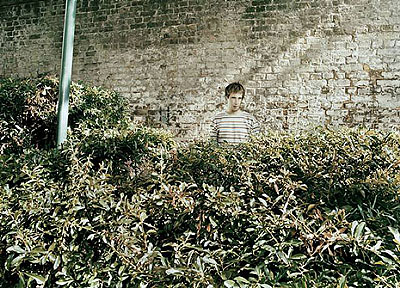
Gabriel Jones »
Somewhere on time
Exhibition: 3 Sep – 15 Oct 2005
Galerie Bugdahn und Kaimer
Düsseldorfer Str. 6
40545 Düsseldorf
Galerie Bugdahn Office
Luegallee 18
40545 Düsseldorf
0211-329140
bugdahn.kaimer@t-online.de
www.bugdahnundkaimer.com
Tue-Fri 12-18, Sat 12-16
Born in Montréal, Canada, in 1973, Gabriel Jones attended a school of photography there. Not long ago he moved to New York, where he has set up his studio. There have been exhibitions of his work in Europe and America; now, Galerie Bugdahn und Kaimer are able to introduce this artist to the German-speaking public with new photographic works from the set entitled, generically, 'Somewhere on Time'. The fourteen coloured photographs, matt-laminated and mounted on Dibond, are in various formats ranging from 28 x 51 cm / 11 x 20 ins (edition of 7) to 115 x 160 cm / 45 x 63 ins (edition of 5). All the works show young female or male individuals in the urban or rural outdoors; the poses taken up by the individuals are specific: each very different and highly characteristic. In most cases, the sitter's gaze is directed somewhere within the picture space, there is no communication with the viewer. The conspicuously fine grain of these pictures renders a great wealth of detail while thereby undermining any hierarchic emphasis on single objects. Jones takes his photographs in outdoor contexts but in 'studio conditions' in the sense that he complements the natural light with artificial sources. This explains the absence of shadows and the subtly surreal air these pieces emanate. The artist's only digital intervention concerns the colours and sets the key tone of the entire series – homogeneous, as if washed out, dominated by grey, green and brown. Jones's is a lucid recording of scenes from the habitual unspectacular round of life. Allied with the pensive, oblivious expression on the figures' faces, the overall mood is intense and melancholy. That tone is resonant in titles such as Remembering, Widow, Falling, Deception, Lost and End; only to be counteracted by others such as Hope, Begin, Escape and Being, which link a responsiveness to the past with the present and with a sense of departure into the future. There is a basic ambivalence, a tension between the brief accentuated moment and an undefined, extended period of time, definition and the inexpressible, beginning with the implications in the set's title of 'Somewhere on Time' - of the contrast between an indefinite location/space and a fixed point in time. In the pictures themselves, this element of tension is repeated by the contrast of inanimate (durable) architectural background and the human figures in action in front of it, of stagnation and venture – but, in particular, generated by the difference between gesture (a spontaneous movement to express something) and the 'frozen' pose (a stage-directed position taken up, for example, by a painter's or a sculptor's model), a discrepancy that Jones highlights and plays with. Precisely because his photographs are able to fix fragments of an instant that we would otherwise most likely miss – the finest nuances out of the breadth and depth of human gesture – they both give the moments permance and extend them into a pose. It is a mark of these works that they have no need of the convention of casting their central figures as appealing heroes and heroines by deploying stock spectacular poses of calculated dramatic effect; here gesture and pose reveal their owners' most private and fragile aspects, and by identification, those of the viewer also. Attempts to give a precise name to the genre of Gabriel Jones's photographs confront one with a many-layered complex of different classes. The top layer is clearly 'portraiture' but of a kind that gives such attention to the depiction of the highly conscious choice of environments that the photographs also work as portraits of architecture or landscape. There are elements of social and fashion photography. The autonomy of the surroundings accords with their function of reflecting or heightening the identity of the human subjects. Sometimes the spatial context possesses the figures in all but animistic fashion, appearing to smother and entwine them in rampant growth (Lost, Being, Close, Deception). Then again, the impenetrable screen of an all-over structure delimited only by the edges of the picture support often enough lends the sitters a backdrop before which they are positioned like an actor in a film still or the figures in a painting. The onlooker becomes a witness in a manner at once disquieting and intriguing, of covert mechanisms of the human psyche.


